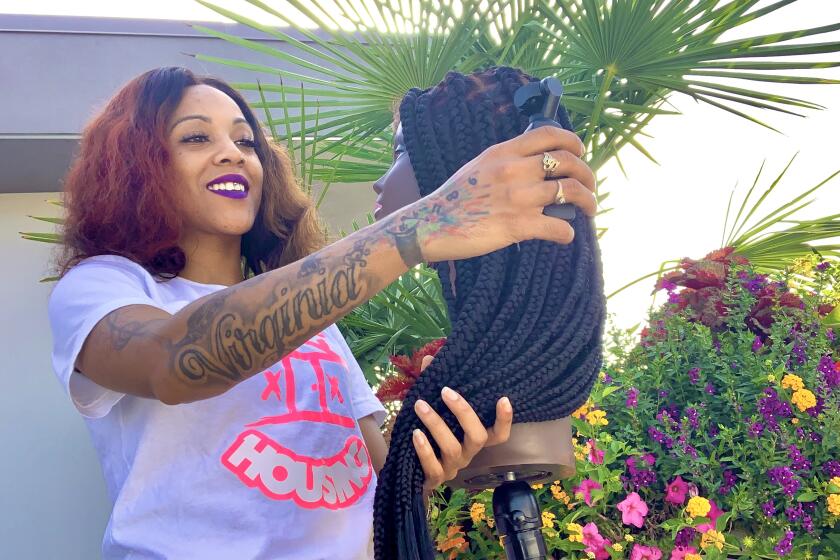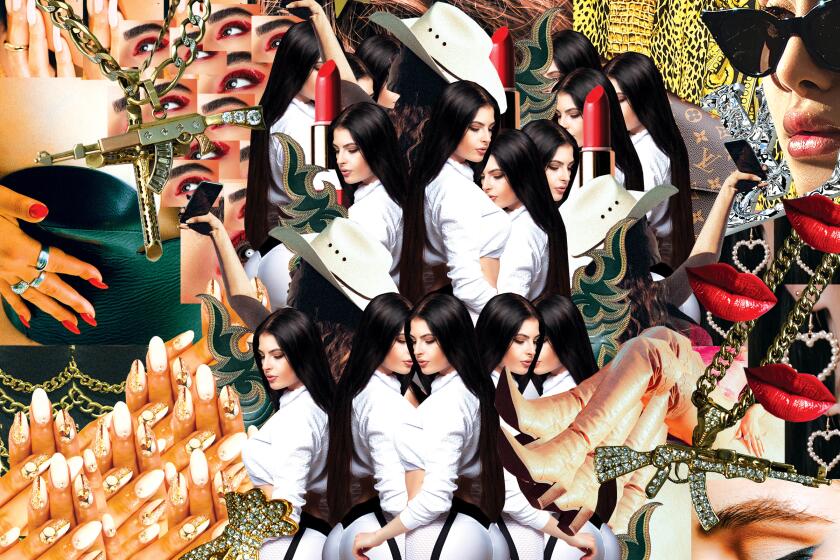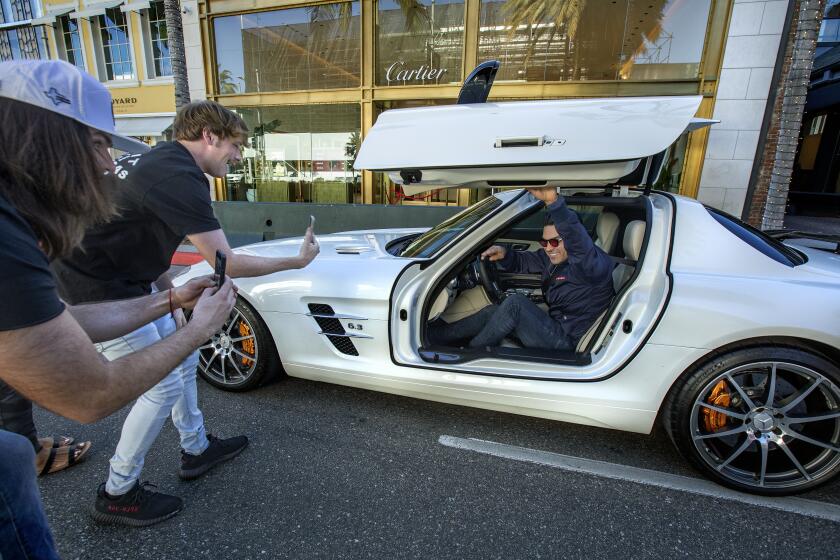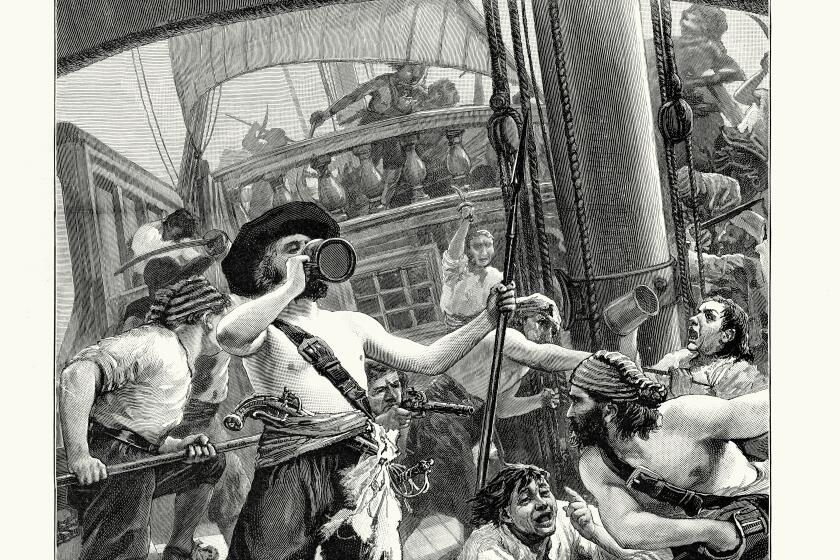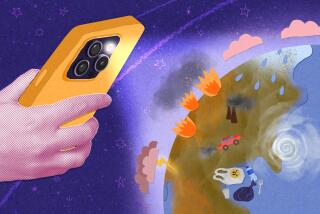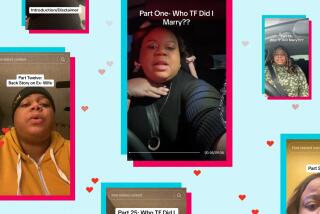Shira Inbar / For The Times
If Franz Kafka were to reconceive âThe Metamorphosisâ for our era, he might decide to ditch the novella in favor of a series of surreal TikToks â Gregor Samsa as eyes and mouth green-screened onto a picture of a roach jacked from the web.
Kafka is long gone. But thankfully, we have Kendria Bland, a Mississippi comedian who does a semiregular bit on TikTok about the travails of a pack of domestic roaches who like to party behind the refrigerator and sneak Popeyes when the humans arenât around. One defiant arthropod, Roachkeishiana, refuses to scuttle when the lights come on and crafts a wig out of hair she finds in the bathtub. âYou know how many times I got stepped on?â she says with a haughty hair toss. âIâm still here.â
The skits bring together a complex array of sight gags while winking at the tropes of âhood films and sensationalist talk shows. But the production values couldnât be more lo-fi: Bland plays every role with different wigs and uses TikTokâs editing tools to green-screen herself twerking on a kitchen table and fighting a pair of beetles. The crude special effects wonât win her an Oscar, but on TikTok, perfection takes a backseat to wit.
Blandâs comedy represents TikTokâs promise. The app, which presents short-form videos in a frantic endless scroll, is governed by (famously creepy) algorithms that deliver posts to those deemed likely to enjoy them â which is how a one-minute cockroach skit by a comedian in Vossburg, Miss., can draw 1.3 million likes and be shared almost 90,000 times, including by me. (I am here for all cucaracha content.)

Despite â or rather because of â its ubiquity, TikTok finds itself in the crosshairs. The app has long raised concerns for the ways its parent company, the Chinese tech firm ByteDance, may employ the mountains of data it harvests from its users. Just before Christmas, a report unearthed evidence that ByteDance employees â already criticized for suppressing content such as Black Lives Matter posts â had taken an even more Orwellian turn, using location data to track journalists. Some university campuses in the U.S. have banned the app from their networks and numerous states prohibit it on government devices. And a newly signed federal law has extended the ban to all government devices.
The alarm over security hasnât put a damper on the app. TikTok couldnât be more popular â especially among teenagers. It has had more than 3 billion downloads globally and its engagement rates outdo Facebook and Instagram. It is relentlessly sticky â addictive, one might say. And whatever its fate, it has already transformed culture: reshaping language, turning dance moves into social currency and making video into something we watch vertically rather than horizontally. When Noodle, a TikTok-famous pug died last month, obituaries proliferated across news media. The last pop concert you went to? Its set may have been inspired by the aesthetics of TikTok.
What are those aesthetics? An app as acutely atomized as TikTok can make those a challenge to articulate. So I have borrowed the format of âNotes on Camp,â in which the ultimate high-low interpreter, Susan Sontag, attempts to pin down the elusive sensibility that is camp. âMany things in the world have not been named,â she writes in the opener, âand many things, even if they have been named, have never been described.â
So with apologies to Sontag, here are my notes on TikTok:
1. The TikTok aesthetic is an anti-aesthetic.
Instagram, with its historically square frame and vaguely cursive font (formally known as Instagram Sans), is the âLive Laugh Loveâ pillow of the social media apps â evoking high gloss and photogenic meals. Facebookâs dull-blue interface feels so bureaucratic that critic Joanne McNeil once wrote that it looked âas if a government body were running it.â
TikTokâs design, by contrast, is almost no design. On a phone, practically the entire window is handed over to video, with controls discreetly laid out around the right and bottom edges. There are no brightly colored frames. TikTokâs logo rarely even comes into view â usually only appearing when a video is shared.
This design reduces the presence of any one person or brand. Handles and avatars of content creators are so minimal they almost elude legibility. I am a fan of numerous creators on TikTok. Iâd be hard-pressed to name more than a few of them.
Many Black TikTok creators say the platform exploits their content while suppressing their voices. For some, the only solution is to pick up and move to other platforms.
2. TikTokâs non-aesthetic promotes a perceived informality.
If Instagram is the airbrushed influencer, TikTok is the friend you talk trash with at the end of the day. TikTokkers face the camera in bathrobes and hair bonnets while sitting in their cars or standing before their bathroom mirror. A common convention is for people to film themselves while tucked into bed.
I follow Shabaz Ali (@shabazsays) for his biting duets (these allow TikTok users to place their own video side by side with another). In his bits, Ali offers running commentary on videos that feature ostentatious displays of wealth â such as a poolside doghouse or a heated driveway. In each post he is lying down, wrapped in a fuzzy fleece blanket. If you happen to be sprawled on a couch while scrolling TikTok (which I overwhelmingly am), the sensation is of being on a video call together, sharing an eye roll over the worst rich people habits.
Except that youâre not.
3. On TikTok, you donât follow people, you follow an algorithm. Or, rather, the algorithm follows you.
Unlike other apps, TikTok doesnât require you to follow anybody in order to view videos. In fact, the app undermines the practice, shooting videos straight to the For You Page (a.k.a. the FYP), which greets you every time you log on. That feed is driven not by your careful selections but by algorithms.
In 2020, TikTok offered a cursory explainer on this recommendation system, which is drawn from your deviceâs settings as well as your habits. âA strong indicator of interest, such as whether a user finishes watching a longer video from beginning to end,â the post explains, âwould receive greater weight than a weak indicator, such as whether the videoâs viewer and creator are both in the same country.â
Alex Zhu, the Chinese tech entrepreneur who devised TikTokâs progenitor, the lip-syncing app Musical.ly, has likened these algorithms to a set of âinvisible hands.â But the New Yorkerâs Jia Tolentino has a better metaphor: âSome social algorithms are like bossy waiters: they solicit your preferences and then recommend a menu. TikTok orders you dinner by watching you look at food.â
When you first land on TikTok, it is a fire hose of random content. But once the algorithm plugs its feelers into your brain, it starts feeding you videos suited to your sensibilities. I currently sit at a confluence of various socially useless Toks â among them, Latin American Meme-Tok, Awkward Christianity-Tok and Rudy Valencia-Tok (the unfolding story of an everyday cuate who appears to have been busted on the app for cheating on both his wife and his mistress, inspiring telenovela levels of plot deconstruction).
Buchona style, which flaunts consumerist excess, emerged from Mexicoâs narco culture and has gone global. Check Jenny69âs viral YouTube single for a tutorial.
This hyperspecialization makes TikTok incredibly sticky. Imagine a TV channel geared to your most peculiar tastes. (There is, indeed, a whole corner of TikTok devoted to lampooning TikTokâs habit-forming qualities.)
But it can also suck you into an algorithmic hole. Voxâs Sara Morrison recently wrote about how TikTokâs algorithm had pummeled her with videos related to trauma and death. âWhat I am getting is a glimpse at just how aggressive TikTok is when it comes to deciding what content it thinks users want to see and pushing it on them.â
4. TikTokâs megastars get the spotlight, but itâs the randos who feed the addiction.
The big TikTok influencers with tens of millions of followers â such as Charli DâAmelio and Khaby Lame â are the ones who land media profiles and sponsorship deals. But ultimately TikTokâs appeal rests on that endless scroll of content being shoveled into your lizard brain. That means lots of little posts from people whose content youâve never seen before and are liable never to see again.
A good night on TikTok â my TikTok, at least â is a thoughtful armchair analysis of Netflixâs âHarry & Meghan,â a Korean grandma transforming leftover Costco chicken into a sumptuous kalguksu and an old man riding a cow along a major thoroughfare in the Central Valley. On their own, these videos would never rise to the level of must-see anything. But in the aggregate, it becomes entertaining â like chatting with a group of witty (algorithmically selected) friends at a party: âYou wonât believe it, but on the way over here, I saw a guy riding a cow.â
Naturally, this raises questions about the ways in which we all labor for free to generate content for social media companies. (Thatâs a story for another time.) But itâs also indicative of how a virtual nobody can become TikTok famous overnight. Put up a compelling post â say, a toddler dancing on a table at a mountaintop rave â and it will be dueted, parodied, imitated and shared ad infinitum, including by Ukrainian soldiers on the front line.
Russiaâs invasion is seen through a generational lens on social media, where Gen Xers frequently cast themselves as the momentâs seers.
5. TikTok prizes performance.
Kylie Jennerâs posing might work as a still image on Instagram, but it feels like dead air on TikTok. The short-form video format favors action, which is why spoofs about the Kardashians are far more engaging to watch than the Kardashians themselves. (Iâm a devotee of Yuri Lamasbella (@yurilamasbella), who, armed with a few wigs and a ring light, perfectly skewers their expressionless affect.)
Commentary, comedy, music, movement, dance, clever cuts, found footage, catchy audio and animals doing funny things are all grist. Sometimes itâs a truly bizarre combination of all of the above, such as a surreal nine-second collage of tigers and a motorcycle racing through a cornfield with footage of Turkish TikTok influencer Yasin Cengiz â known for making his belly bounce when he dances â superimposed on top.
A viral sensation on TikTok and Instagram, Daniel Macdonaldâs simple shtick has made him as rich as many of the drivers whose ultra-high-end cars he films.
The manic nature of these short films â which began as 15-second videos when TikTok launched in 2016 and can now run to 10 minutes in length â feel like a return to the roots of cinema. Thomas Edisonâs early Kinetoscope films from the late 19th century, short looped films seen via a viewing cabinet, come to mind. These mini-movies featured boxing, acrobats and a body builder flexing his muscles â films full of frenzied physical activity to convey the radical nature of the new motion pictures.
Naturally, fragments of old Kinetscope films have made their way onto TikTok.
6. TikTok prizes repetition.
Manic performance reads well on an app on which you have about six seconds to grab someoneâs attention. So does repetition. If a concept or visual gag gains traction, repeating it can extend the moment.
For the record:
6:28 p.m. Jan. 4, 2023A previous version of this story mis-titled a Boney M. song as âMa Rainey.â It is âMa Baker.â
A man dancing in a public square in Asia set to Boney M.âs âMa Bakerâ becomes popular, so the account holder posts endless variations. Fijian TikTokker Shaheel Prasad (@shermont22) goes viral for his spoofs of runway models, strutting barefoot while bearing pieces of hardware as if they were haute couture, so he produces dozens of similar posts. âThis is a trend that will be bound to end,â he told the New York Timesâ Guy Trebay. âBut meanwhile I will try to keep doing it as long as I can.â
Repetition moves across accounts too. A popular tune â say, a remix of Busta Rhymeâs âTouch Itâ or Armani Whiteâs âBillie Eilishâ â can become a staple for videos featuring smash-cut wardrobe changes. Songs, settings, movements, dances and concepts are relentlessly rehashed, wringing a measure of soothing predictability from TikTokâs general anarchy. It also creates a low barrier for entry: Users donât have to be original to achieve prominence; all they need is a clever spin on a trending hashtag.
Ultimately, the endless repetition can feel like a trap. Iâve seen some creators repeat concepts to the point of exhaustion. It brings to mind an early episode of âBlack Mirrorâ in which Daniel Kaluuya plays a man in a technological dystopia: Suffering a break over the exploitative practices of a nameless entertainment state, he threatens to kill himself with a shard of glass during a live broadcast. This reckless act of candid expression proves so popular that he is condemned to repeat the act every night.
A very British novelty rap from a 2000 documentary was excavated, remixed and is now a viral smash on TikTok.
7. TikTok is an ouroboros of looking.
On Instagram, if you feel passionately about a post, you can leave a comment. On Twitter, you can retweet and add a comment. But TikTok is unique in its duet function, which has spawned a near-infinite array of reaction videos commenting alongside other posts â like a hall of mirrors, or that Greek snake of antiquity eating its own tail.
A staggering number of duets involve one person commenting on the kitchen prep of another. (TikTokker @chefreactions is a master in this category, a professional chef known for verbally dismembering hack recipes: âThat looks as if E.T. ended in a tragic house fire.â) And, of course, thereâs the duet train, in which one user pairs her video with another who pairs it with another and another â like a digital exquisite corpse. The format was employed to terrific effect on the sea shanty âSoon May the Wellerman Come,â which went viral last year, allowing performers to add successive layers to the original song.
The duet is one of the most intriguing aspects of the app: a form of looking that is far more active than clicking âlike.â Even more intriguing: Many duets are very simple in nature, featuring one person quietly observing rather than offering a judgmental reaction. These calm expressions of looking rarely go viral. But there is something affirming about them.
It recalls a point once made by critic John Berger. âSoon after we can see, we are aware that we can also be seen,â he wrote. âThe eye of the other combines with our own eye to make it fully credible that we are part of the visible world.â
A leading maritime music scholar marvels at the virality of #ShantyTok, as a nation of teens and 20-somethings howl about sugar and tea and rum.
8. TikTok is real life.
If all of this seems irrelevant because you arenât on TikTok, well, TikTok has found its way to you regardless.
The TikTok effect has sent Big Tech back to the drawing board on long-established apps. In July, a Google exec revealed at a conference that, according to internal studies, 40% of young people turn to TikTok or Instagram when looking for a basic service like lunch â not a search engine like Google. Since then, Google has made user reviews much more prominent on its maps and now delivers many more images, graphic text boxes and social media feeds in its results.
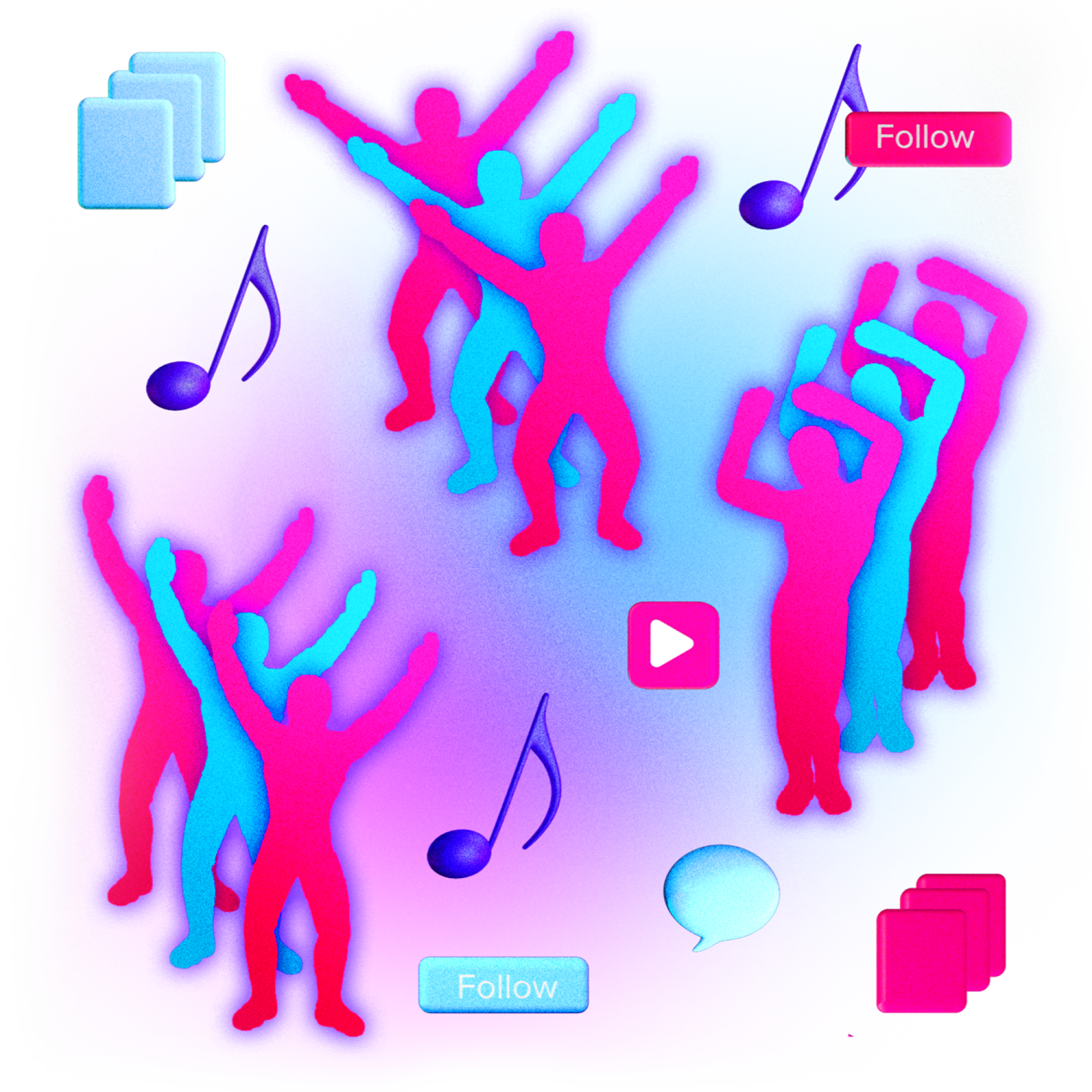
And the influence extends beyond the internet. TikTok has inserted new slang into the language and generated new works of theater. (Remember the fans of Pixarâs âRatatouilleâ who essentially crowdsourced a musical that wound up on a New York stage?) And the app is a juggernaut in the music industry, where new songs and old ones alike can become hits â like Fleetwood Macâs âDreams,â which became a cultural touchstone after being resuscitated by an Idaho skateboarder with a taste for cranberry juice in 2020. Now performers such as Megan Thee Stallion collaborate with TikTok to test the waters on singles releases.
But the TikTok effect goes beyond basic virality; its aesthetics manifest within the literal architecture of art.
RosalĂaâs Motomami tour featured a stripped-down set with three vertical screens that projected live images of the singer and her dancers. Green-screen effects were employed, showing the singer playing piano, for example, against a backdrop of rolling green hills. (Very TikTok.) The climax was the moment RosalĂa launched into the hit âBizcochito.â The choreography begins with a familiar viral gesture of the singer standing with her hand on one hip, pretending to chew gum while looking annoyed.
When I attended her concert in October, this pantomime had been all over TikTok for weeks. When the sequence began, the crowd roared in response. Cellphones went up. And the young woman seated in front of me recorded the sequence and uploaded it to TikTok. TikTok came to life, then promptly became more content for TikTok.
To TikTok, we submit our gaze. And through the filter of the algorithm we find it projected back at us â broken down and commodified into bite-size morsels that might feel like the intimate dispatches of a thousand individuals but, in the end, are simply the output of an opaque, all-knowing machine.
More to Read
The biggest entertainment stories
Get our big stories about Hollywood, film, television, music, arts, culture and more right in your inbox as soon as they publish.
You may occasionally receive promotional content from the Los Angeles Times.
